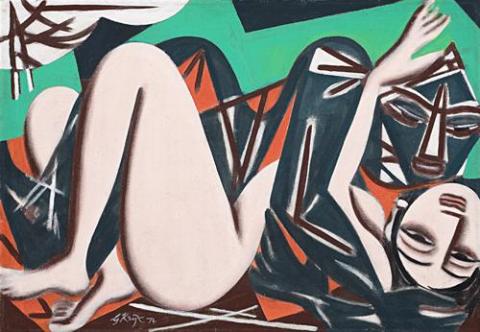DIVINE UNION, 1974
George Keyt
oil on canvas on board
69.0 x 99.5 cm
signed and dated lower left: G Keyt 74
Halpe, A., George Keyt, The George Keyt Felicitation Committee, Colombo, 1977, p. 74 (illus.)
Combining the inspiring discipline and austerity of an Indian seer with the verve and sparkle of the European experimentalist, George Keyt is widely regarded as Sri Lanka's only truly universal artist - his art symbolising a synthesis of East and West that is unique both within the Hindu idiom and twentieth-century painting generally.
A Ceylonese of Indo-Dutch descent, Keyt embarked upon his career as an artist in 1927, a time when '...there was no longer any art which was both Sri Lankan and modern.'1 Rejecting the stifling valuesof the Victorian milieu in which he had been raised, he thus sought moral and spiritual refreshment in Kandyan rural culture, immersing himself in Buddhist thought and Sinhala poetry at the ancient hill capital, Malwatte Vihare. Importantly, it was this experience of Hindu and Sinhala iconography (gleaned directly from the striking medieval temple frescoes and sculpture), together with his later appreciation of contemporary French painting (through the illustrations featured in the art magazine Cahiers D'Art) that would exert the most enduring influence upon his highly stylised, sensuous compositions such as Divine Union, 1974.
Encapsulating his predilection for poetry and romance subjects - and particularly those concerning the pursuits and affections of the gods of Hindu mythology - the present work illustrates well the artist's striking stylistic affinities with his European contemporaries. The distinctly cubist formula of the oval face with sharp profile simultaneously rendered, together with the structural rendering of curvilinear forms and general distortion of the human figure is unmistakably reminiscent of Braque, Picasso and Leger. However, in spirit, Keyt's aesthetic evokes the voluptuous, reclining nudes of Matisse which, with their warm intimate colour and elegant line, celebrate woman as majestic, poetic and lovingly tender.
1. Archer, W.G., 'The Early Phase' in Halpe, A., George Keyt, The George Keyt Felicitation Committee, Colombo, 1977, p. 29
VERONICA ANGELATOS
